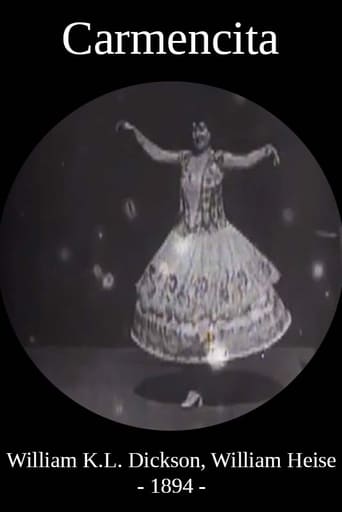He_who_lurks
A popular theme in Edison's earliest Kinetoscope films was often dancing, which he apparently thought would be entertaining to audiences. This film is among these various dance routines the company filmed, this time featuring the Carmencita of the title doing her dance for the camera before curtsying. That is really all we see but the dance is interesting for a number of reasons. It caused censorship during its time, and while not understandable today the Victorian values of the time made it become undeniably scandalous. The dance isn't anything really interesting by itself, but apparently Carmencita made lots of money off of it, and was well known at the time. If it weren't for this movie she'd probably be forgotten today. That is another reason these early Edison pictures are interesting: they portray long-dead, long-forgotten performers. Without these 23 seconds we'd probably have forgotten all about Miss Carmencita now and nobody would be on IMDb bothering to review this. Then again, the page itself wouldn't even be there!
Michael_Elliott
Carmencita (1894) *** 1/2 (out of 4)Infamous Edison short, which features the title dancer, quite famous at the time, doing one of her dances. The film runs only 24-seconds but who today could really imagine how much trouble this film would get into with such a short running time. The movie was famous because it came under a lot of censorship issues wherever it would be played. The most famous incident happened in Boston where it was pulled from theaters after a preacher complained that it was sinful. We only see a brief bit of the dancer's leg (below the knee) so that should tell you something. There's certainly nothing great here but from a historical standpoint this is a very important film.
Snow Leopard
This is the first movie in what quickly became one of the most popular genres in the earliest years of motion pictures. Many of Edison's earliest Kinetoscope films featured popular dancers, the best known probably being Annabelle (Whitford) Moore. But "Carmencita" was the first such feature and, as best as anyone has been able to determine, the dancer herself also became the first woman to appear in an American-made movie.The dance routine itself is similar in style and quality to most of the other movies of its kind and era. The completely dark background makes "Carmencita" herself the full focus of attention. Her appeal is said to have been based as much on her energy and fervor as on her actual skill in dancing, and even with the limitations of 1890s cinematography, it's easy to tell that she is enthusiastic about what she is doing. Her stage routine was probably even livelier.It's not hard to guess why this kind of movie was so popular in its time. This and similar features could provide something worth seeing within the very limited running time of the earliest movies. Some of the later movies of popular dancers display more film-making experience, but "Carmencita" got the genre off to a lively start.
Brian-59
"Carmencita Dancing," one of a series of Edison short films featuring circus and vaudeville acts, displayed the... um... "talents" of a zaftig belly-dancer who agreed to undulate before the camera of the famous "Black Maria" studio. The dance was originally intended to be played in a Kinetoscope, a single -person arcade viewer connected to Edison's more famous invention, the phonograph. Through a pair of crude headphones, the latter device supplied an asynchronous soundtrack of "hootchie-cootchie" music. The Kinetograph camera here employed is so new -- even to its inventors -- that director Dickson has drastically "overcranked" the film, unintentionally producing one of the first examples of slow-motion. Carmencita's titillating movements were considered by many to be scandalous. Thus, the film prompted some of the earliest discussions of film censorship.


